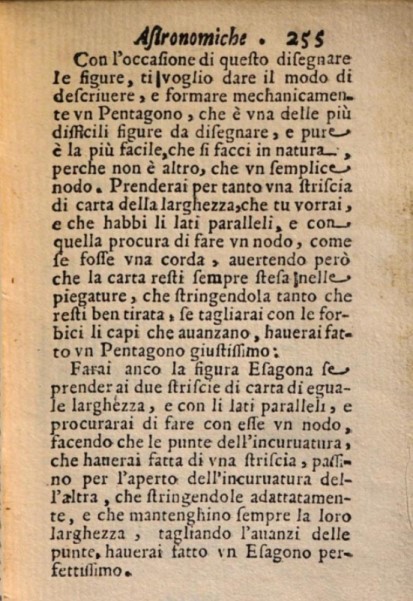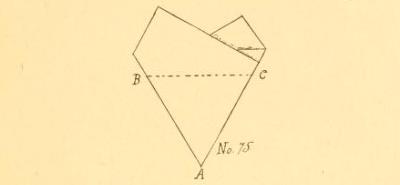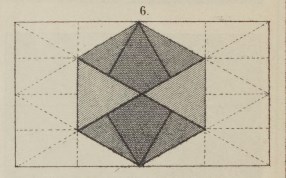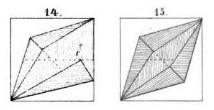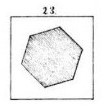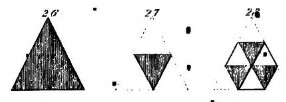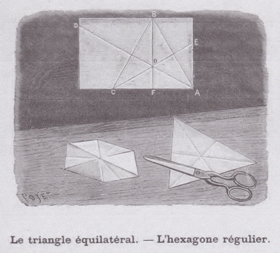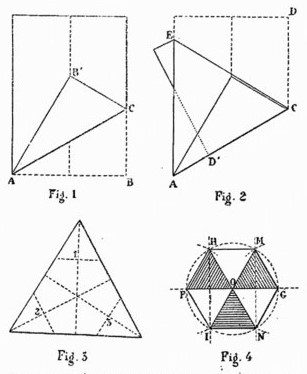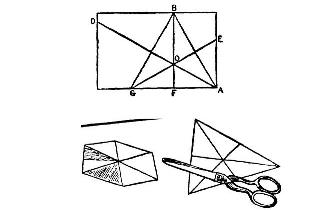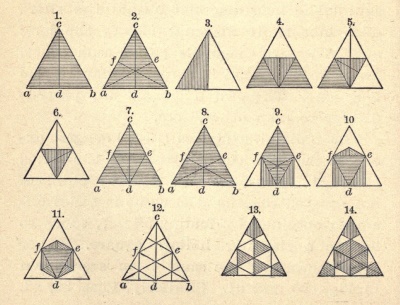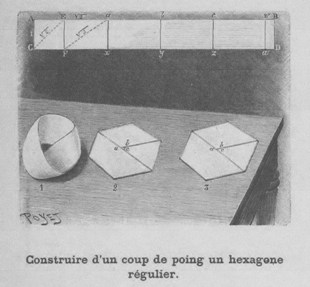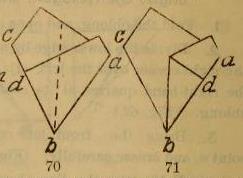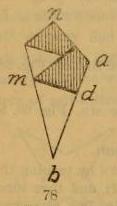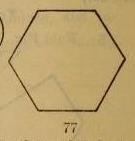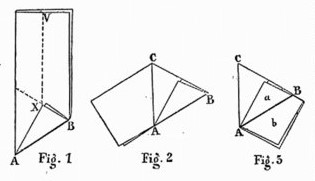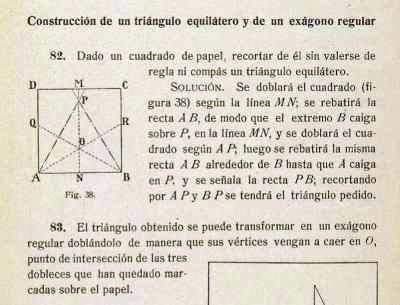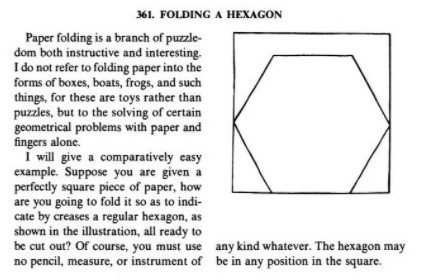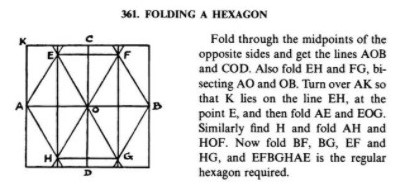| The Public Paperfolding History Project
Last updated 14/11/2025 x |
|||||||
| How to Construct the Regular Hexagon by Folding Paper | |||||||
| This
page is being used to collect information about the
history of ways of constructing the regular hexagon by
folding paper. Please contact me if you know any of this
information is incorrect or if you have any other
information that should be added. Thank you. ********** Method 1 - From two strips knotted together - 1682 onwards 1682 A description of how to fold a hexagonal knot appears in the 1682 second edition of 'Trattato Della Sfera' in a section called 'Prattische Astronomonische. Intorno all circoli della Sfera' which was an addition to the original work by Urban d'Aviso and did not appear in the 1656 first edition. (The first paragraph explains how to fold a pentagonal knot.)
The second paragraph can be translated, roughly, as 'You can also make a figure in the shape of a hexagon if you take two strips of paper of equal length, and with the sides parallel, and make a knot with them, making the tips of the curvature of one strip, pass through the opening of the curvature of the other, so that by tightening them properly, always keeping their width and cutting the leftovers of the tips, you will have made a true Hexagon.' ********** Method 2 - Froebel's Fold and One Cut Method from a square - 1859 onwards
********** Method 3 - From a bronze rectangle 1863 An illustration which depicts the construction of a hexagon from a bronze rectangle appears in 'De Kleine Papierwerkers 1: Wat men van een stukje papier al maken kan: Het vouwen' (The Small Paperwork 1: What one can make from a piece of paper: Folding) by Elise Van Calcar, which was published by K H Schadd in Amsterdam in 1863.
********** Method 4 - Kohler's method from a square - 1872 onwards 1872 The second 'expanded and improved' edition of 'Das Frobel'sche Faltblatt' (Frobel's Folding Sheet) ) by August Kohler, which was published by Hermann Bohlau in Weimar in 1872, contains a method of constructing a regular hexagon.
********** Various similar / other methods of constructing the regular hexagon by folding appear in: 1873 'Die Praxis Des Kindergartens' by Auguste Koehler, which was published by Herman Bohlau in Weimar in 1873 contains a method of producing a regular hexagon by truncating a diamond folded from a square.
********** Method 5 - From an equilateral triangle (1) - 1877 onwards 1877 'Kindergarten Practice' by Mary Gurney, a substantially abridged version, in two parts, of 'Die Praxis Des Kindergartens' by Auguste Koehler. The second part, 'Froebel's Plane Surfaces', contains sections dealing with paper folding, cutting and weaving. The date of the first edition is not known. The second edition was published in 1877 in London by A N Myers and Co.
********** 1891 In Volume 2 of 'La Science Amusante' by Tom Tit (real name Arthur Good), which was published in Paris by Librairie Larousse in 1891.
********** 1894 In an article by J Marteau in Manuel General de L'Instruction Primaire, 4th August 1894.
********** 1918 'Scientific Amusements' (an English translation of some of the material from volumes 2 and 3 of 'La Science Amusante' by Tom Tit) which was published by Thomas Nelson and Sons Ltd in London in 1918.
********** 1913 'Trabajo Manual' by C Champy Alvear, which was published by Cabaut y Cia in Buenos Aires in 1913, provides five ways of obtaining a regular hexagon by folding paper:
********** Method 6 - From an equilateral triangle (2) - 1887 onwards 1887 'Primary Methods: A Complete and Methodical Presentation of the Use of Kindergarten Material in the Primary School' by W N Hailmann, which was published by A S Barnes and Company in New York and Chicago in 1887, gives a second way of obtaining a hexagon from an equilateral triangle.
********** 1913 'Trabajo Manual' by C Champy Alvear, which was published by Cabaut y Cia in Buenos Aires in 1913, provides five ways of obtaining a regular hexagon by folding paper:
********** 1891 There is reference to constructing a hexagon from a square in the 'Bulletin de la Societe de Protection des Apprentis', an official document issued by the Societe de Protection des Apprentis et des Enfants Employes par les Manufactures in Paris in 1891. ********** Method 7 - From a Mobius Band by Un Coup de Poing - 1893 onwards
********** Method 8 - Variation of Froebel's method 1894 This method also appears in 'Old Glory: The Flag of Our Country: A Study in History and a Lesson in Paperfolding: Also Some Easy Lessons in Cutting and Folding' by Dr Albert Elias Maltby, which was published in Slippery Rock, Pennsylvania in 1894.
********** Method 9 Another fold and one cut method of constructing a hexagon from an oblong appears in an article by J Marteau in Manuel General de L'Instruction Primaire, October 1894.
********** 1900 The same methodappears in an article in El Monitor 331 of 30th September 1900 (which is a translation of several chapters of Savineau).
********** Method 10 1913 'Trabajo Manual' by C Champy Alvear, which was published by Cabaut y Cia in Buenos Aires in 1913, provides five ways of obtaining a regular hexagon by folding paper: A hexagon woven from a strip
********** Method 11 1913 'Trabajo Manual' by C Champy Alvear, which was published by Cabaut y Cia in Buenos Aires in 1913, provides five ways of obtaining a regular hexagon by folding paper: Constructing a hexagon from a rectangle
********** 'Ciencia Recreativa' by Jose Estralella, which was published by Gustavo Gili in Barcelona in 1918.
********** 1926 As a puzzle in 'Modern Puzzles' by Henry Ernest Dudeney, which was published by C. Arthur Pearson in London in 1926.
Solution
********** 1940 'El Plegado y Cartonaje en la Escuela Primaria' by Antonio M Luchia and Corina Luciani de Luchia, which was published by Editorial Kapelusz in Buenos Aires in 1940, and which contains explanations of two different methods:
***
********** 1951 A method of constructing a regtular hexagon from a rectangle appears in Plegado laminas published by Della Penna, April 1951. Construccion de un exagono regular
********** |
|||||||
